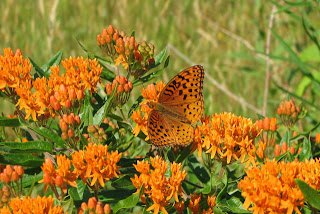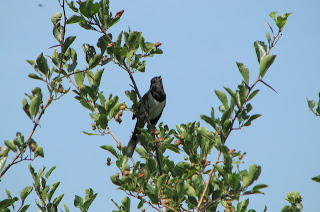Dateline: 28 March 1996, Torrey Pines State Reserve, California
As luck would have it, spring break 1996 at the University of Arkansas roughly coincided with the Cooper Ornithological Society's meeting in San Diego, California. Donna and I checked our calendars and realized we could spend a week camping through the desert southwest, ending up visiting friends in Tucson, Arizona. From there, Donna would head back to Fayetteville and I'd parade onward to SoCal for a bit more birding and then attend the 66th annual COS meeting. Of course, the binoculars would rarely leave my neck for the entire trip.
As it turned out, a (non-birding) friend from school was in San Diego attending a molecular biology conference. Through him I met a birder from Scotland who had never been to the States. A match made in birder heaven: Ian desperately wanted to go birding but had no car; I had a car, a copy of "Birdfinding in Southern California," and was psyched for some birding company.
We went out birding the next morning, making a long day looking for California Gnatcatchers, Light-footed Clapper Rails, Wandering Tattlers, Black Skimmers, Wrentits, and whatever other North American west coast specialties Ian was interested in. After a morning of scoping, pishing, and otherwise raising the Border Patrol's curiosity between San Diego and the Mexican border we headed north of La Jolla, targeting Torrey Pines State Reserve as our next stop. This location came highly recommended, though exactly why escapes me now. Probably less for the birds and more to experience the rare Torrey Pine trees and the unique chaparral habitat, described as a remnant of wilderness amidst constant development.
 A Torrey Pine in its native habitat, rare to see in
A Torrey Pine in its native habitat, rare to see inthe wild. Photograph taken by Rsduhamel.
Unfortunately, our directions were a bit sketchy. We eventually found a sign for the reserve but were too cheap to pay for parking, so we wound our way north looking for a suitable, and free, parking area. We did eventually find an area filled with folks flying kites and model airplanes, or just hanging out in the afternoon sunshine. Most importantly, it had a place to park and places to easily watch the Pacific from the cliff we were perched on. We unloaded our scopes and field guides and found a spot to scope out the ocean and the beach below, our minds filled with images of shorebirds, gulls, terns, and perhaps a pelagic species or two.
I don't remember if we identified or even saw anything, but at one point I heard Ian's lilted, "Hullo, what's this?" which I learned was his way of saying he's got something interesting. I glanced over to see where he was looking, beach or ocean, but it turned out neither. Instead, he's got his binoculars pointed a couple of hundred yards away from where we stood on the cliff, but not focused on a bird, but on a guy in a baseball hat and beige birding vest looking through a scope: a birder in the know! We decided we should stand near him rather than on our own, much like a migrant passerine joining a resident chickadee flock.
 The view from Torrey Pines State Reserve. It looks like a great spot to
The view from Torrey Pines State Reserve. It looks like a great spot totake in the ocean and, hopefully, a few ocean birds. Taken by Xiao Li.
On our way over we noticed a couple other birders, all peering through scopes . . . jack pot! This must be a hot spot, tide must be low, must be some good shorebirds since they're all peering down on the beach rather than out at the ocean. Turns out there were more than a dozen folks with scopes, all focused on a stretch of sand below.
Ian and I set up our scopes, casually looking over to see if we could catch someone's eye to engage in some typical birder dialouge. What are you finding? What "good" birds might we keep an eye out for? Where else we should go this afternoon, is there a good spot for . . .
"HUL-LO, what's THIS!" I jumped to my scope, watching Ian to figure out where he's looking. My hands are somewhat fumbling, it's gotta be an amazing find, judging by the excitement and surprise in his voice. When I finally get my scope focused and start searching the sandy beach I find no birds, only breasts. And other private parts that will make the blog censors blush.
Yep, the "birders" we hastened to join were actually peeping toms spying on the nude beach below. Had we watched more carefully before joining them we would have noticed a few taking some rather amazing liberties in such a public place, treating their bodies "like an amusement park" is how a famous Seinfeld episode described it.
Now a quandary. Do we stay and pretend not to see the nude bodies but keep on birding? Or pack up and run, dissociating ourselves from this crowd? We don't know this place, was it possible there would be a raid any moment? Would we be spending the next few days in a California jail?
We ended up packing up and leaving, but at a casual pace and talking a bit too loudly about Calidris sandpipers, shearwaters and storm-petrels. I'm sure the peepers were looking at us like we were nuts. I would be remiss if I didn't point out that at least this was California, the nude sunbathers (and swimmers, beachcombers, joggers, and volleyballers) were in excellent shape and attractive in that girl-in-a-Beach-Boys-song way.
That is my birds-and-nudity story, the only one I have (to date). I'm sure many, many birders have something similar, I (and others, I bet) would love to hear them, if you're willing to share. One recounting can be heard by Bill Thompson's presentation at this years Space Coast Birding Festival (podcast available, look for Episode #6, "The Perils & Pitfalls of Birding").
Incidentally, in searching out some potentially useful links and some eye-candy for this Flashback I found results from monthly bird surveys at Torrey Pines. I bet they get a lot of volunteers.
- More information about the birds in this post birds can be found at All About Birds | Bird Guide
- More information about recreational nudity can be found at American Association for Nude Recreation
- All images pinched from Wikipedia, used under CreativeCommons licensing.












































